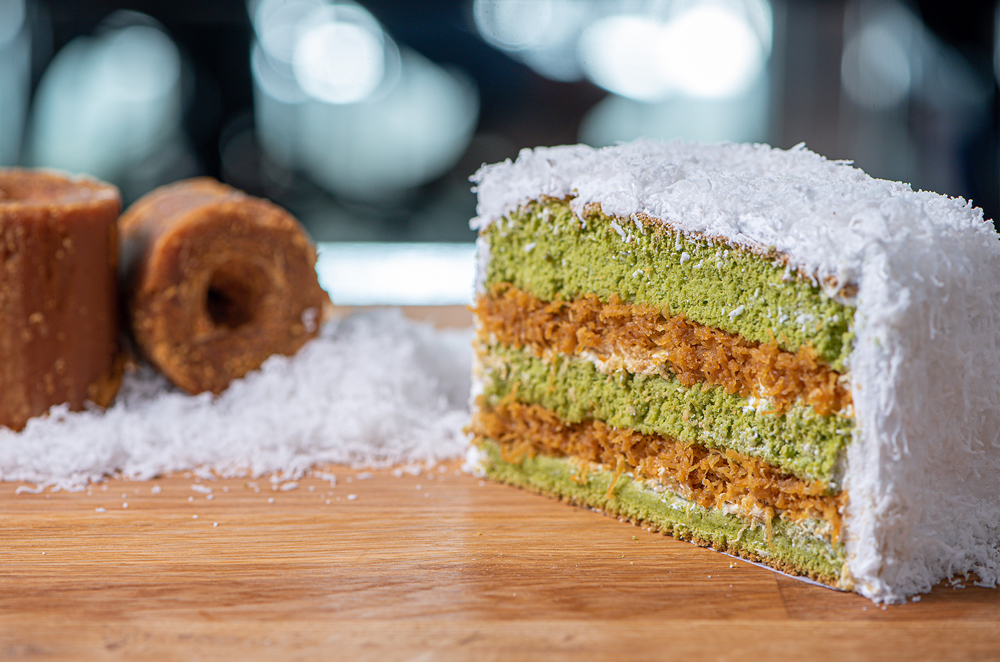The Onde Cake has been delighting dessert lovers for years. This Malaysian dessert offers a sweet, chewy texture and a beautiful blend of flavors. While it has the same name and many similarities to the traditional Onde-Onde (the famous coconut-covered glutinous rice ball filled with palm sugar), the Onde Cake offers a twist with a cake-like texture and additional unique flavor combinations. In this article, we will explore the origins, ingredients, recipe, and cultural significance of the Onde Cake, a must-try treat for both Malaysians and international food lovers alike.
What is Onde Cake?
The Onde Cake is a modern interpretation of the classic Onde-Onde dessert, a popular sweet in Malaysia and other Southeast Asian countries. While Onde-Onde consists of rice flour balls filled with melted palm sugar and rolled in grated coconut, Onde Cake presents the same delicious flavors in a more accessible and visually striking form.
Made with coconut, pandan (screw pine leaf), and palm sugar, the cake is often served as a layer cake, showcasing the vibrant green of pandan and the sweetness of palm sugar. Its moist, chewy texture is one of its defining features, making it a perfect treat for any occasion.
The Origins of Onde Cake
The origins of the Onde Cake can be traced back to the traditional Malay dessert, Onde-Onde. Onde-Onde dates back centuries and has roots in the Peranakan (Straits Chinese) and Malay culinary traditions. While the Onde-Onde is made with glutinous rice flour, the Onde Cake is a cake adaptation of this beloved dessert.
Malaysia’s diverse food culture, which blends Chinese, Malay, Indian, and other influences, has encouraged chefs and home bakers to experiment with traditional recipes. The Onde Cake is a result of this innovation, and it has quickly become a favorite for festive celebrations such as Hari Raya and Chinese New Year.
Key Ingredients in Onde Cake
The ingredients for making Onde Cake are simple, yet they come together to create a beautifully rich flavor. Below are the key ingredients used in preparing this dessert:
- Pandan Extract: The green color of the cake comes from pandan, a tropical leaf known for its aromatic fragrance. Pandan extract gives the cake its distinct flavor, which is sweet and slightly floral.
- Coconut: Grated fresh coconut or desiccated coconut is often used as a topping for the cake. The coconut adds texture and a nutty sweetness.
- Palm Sugar (Gula Melaka): This traditional sugar is made from the sap of palm trees and has a rich caramel flavor. It’s a crucial element in maintaining the authenticity of the Onde Cake, as it mimics the filling of the traditional Onde-Onde.
- Glutinous Rice Flour: In some recipes, a small amount of glutinous rice flour may be added to give the cake a chewier texture, similar to the traditional rice balls.
- Butter and Eggs: These ingredients are used to create a soft and moist cake texture, forming the base of the Onde Cake.
- Coconut Milk: Coconut milk gives the cake a rich, creamy consistency and a slight tropical flavor that complements the pandan and palm sugar.
Making Onde Cake: Step-by-Step Recipe
Now that we’ve covered the ingredients, let’s move on to the process of making this delightful dessert. Below is a basic recipe for Onde Cake that will guide you through each step.
Ingredients:
- 200g cake flour
- 50g glutinous rice flour
- 150g butter (softened)
- 100g sugar
- 100ml coconut milk
- 3 large eggs
- 2 tablespoons pandan extract
- 100g grated coconut (for topping)
- 100g palm sugar (for filling)
Method
- Preheat the Oven: Begin by preheating your oven to 160°C (320°F) and greasing and lining an 8-inch round cake tin.
- Prepare the Palm Sugar Filling: Grate the palm sugar and melt it in a small saucepan over low heat until it becomes syrupy. Set aside to cool.
- Make the Cake Batter: In a large bowl, beat together the butter and sugar until light and fluffy. Add the eggs one at a time, mixing well after each addition.
- Add the Pandan Extract and Coconut Milk: Pour in the pandan extract and coconut milk, and stir to combine.
- Mix the Dry Ingredients: In a separate bowl, sift together the cake flour and glutinous rice flour. Gradually add the dry ingredients to the wet mixture, stirring gently to form a smooth batter.
- Layer the Cake: Pour half of the batter into the prepared cake tin. Gently pour the palm sugar syrup over the batter, making sure it is evenly distributed. Then, pour the remaining batter on top.
- Bake the Cake: Place the cake in the oven and bake for 40-45 minutes, or until a toothpick comes out clean. Allow the cake to cool completely before removing it from the tin.
- Finishing Touch: Once the cake has cooled, sprinkle the grated coconut on top for a final layer of texture and flavor.
Variations of Onde Cake
While the classic Onde Cake is delicious as is, there are several variations you can try. Here are a few ideas:
- Onde Cake with Pandan and Coconut Layers: Some bakers create a layered version of the Onde Cake, alternating layers of pandan and coconut for a visually stunning dessert.
- Onde Cake with a Cream Cheese Frosting: For an added richness, you can frost the cake with a cream cheese layer, giving it a tangy contrast to the sweetness of the cake.
- Onde Cake with Mango: Incorporating tropical fruits like mango into the cake batter or as a topping can add a fresh twist to the traditional recipe.
- Onde Cake with Red Bean Paste: If you enjoy the sweet filling of onde-onde, try adding red bean paste or a sweet mung bean paste as an interior filling in the cake.
The Texture of Onde Cake: Soft and Chewy
One of the highlights of the Onde Cake is its texture. The combination of cake flour and glutinous rice flour gives the cake a soft, spongy crumb that melts in your mouth, while the palm sugar filling adds a chewy, caramelized bite.
The grated coconut on top also adds a delightful crunch that contrasts with the soft cake beneath. This play on textures is one of the reasons why the Onde Cake has gained such popularity.
Onde Cake for Festive Occasions
In Malaysia, the Onde Cake is often prepared for special occasions, particularly Hari Raya (Eid), Chinese New Year, and weddings. The rich and festive flavor profile makes it an ideal dessert for celebrating with family and friends.
During Hari Raya, where traditional Malay sweets such as kuih-muih are served, the Onde Cake adds a refreshing twist to the usual fare. Its vibrant green color, reminiscent of prosperity, also makes it a perfect dessert for celebratory occasions.
The Cultural Significance of Onde Cake
The Onde Cake is more than just a dessert – it is part of Malaysia’s rich food heritage. By combining local ingredients like pandan, palm sugar, and coconut, it celebrates the cultural influences that make Malaysian food so unique.
The use of pandan, in particular, is a hallmark of Southeast Asian cuisine. Pandan leaves are highly aromatic and have been used in cooking for centuries, adding flavor and color to both sweet and savory dishes.
By reinterpreting traditional desserts like Onde-Onde, the Onde Cake pays homage to the culinary roots of Malaysia while introducing modern twists that keep the culture evolving.
Where to Find Onde Cake in Malaysia
While you can easily make Onde Cake at home, many bakeries and cafes in Malaysia offer this treat for those who want to enjoy it without the hassle of making it from scratch. Here are some popular spots where you can find Onde Cake in Malaysia:
- Penang: Known for its vibrant food scene, Penang has several bakeries that offer Onde Cake alongside other traditional Malaysian desserts.
- Kuala Lumpur: In the capital city, cafes and boutique bakeries often serve Onde Cake during festive seasons.
- Malacca: As a city with a rich Peranakan heritage, Malacca is another great place to find Onde Cake, especially in local cafes serving Nyonya food.
Tips for Perfecting Your Onde Cake
To ensure that your Onde Cake turns out perfectly, here are some helpful tips:
- Use Fresh Pandan Extract: The flavor of pandan extract can vary depending on the source. For the best flavor, use fresh pandan leaves or high-quality pandan extract.
- Don’t Overmix the Batter: Overmixing the batter can lead to a dense cake. Mix just until everything is incorporated for the lightest texture.
- Allow the Cake to Cool Completely: Let the cake cool before removing it from the tin. This helps it set properly and prevents it from falling apart.
Conclusion
The Onde Cake is a delectable twist on the traditional Onde-Onde, offering the same beloved flavors in a more cake-like form. With its chewy texture, fragrant pandan flavor, and sweet palm sugar filling, it is a dessert that perfectly encapsulates the essence of Malaysian cuisine. Whether you’re celebrating a festive occasion or simply indulging in something sweet, the Onde Cake is sure to impress.
FAQs
What is the difference between Onde Cake and Onde-Onde?
Onde Cake is a cake version of the traditional Onde-Onde, which are chewy rice balls filled with palm sugar and covered in coconut.
Can I make Onde Cake without pandan extract?
While pandan extract is key to the flavor and color, you can substitute it with vanilla extract and green food coloring if needed.
How long can I store Onde Cake?
You can store Onde Cake in an airtight container at room temperature for up to 3 days. For longer storage, refrigerate it for up to 5 days.
Can I freeze Onde Cake?
Yes, you can freeze Onde Cake. Wrap it tightly in plastic wrap and store it in an airtight container for up to a month. Thaw before serving.
What are some variations of Onde Cake?
Variations include adding cream cheese frosting, using mango as a topping, or incorporating red bean paste for a unique twist on the traditional recipe.
Also read: Plettenberg Bay: 10 Perfect Day Trips for Exploring the Area




Leave a Comment